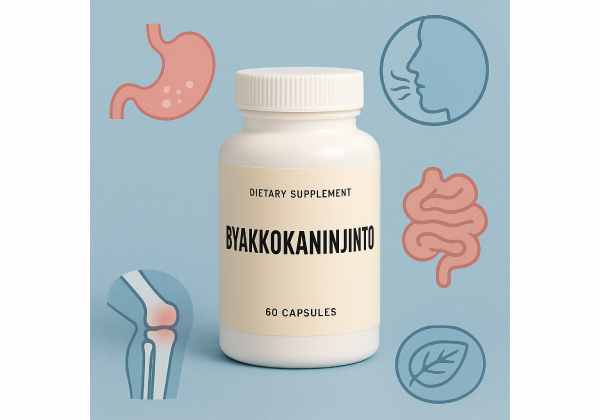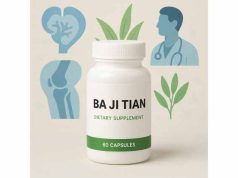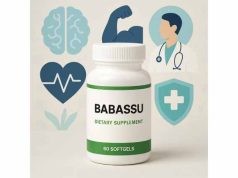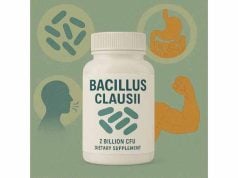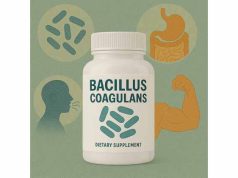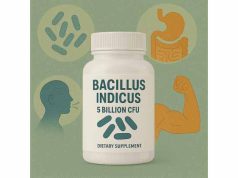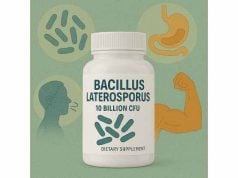Byakkokaninjinto is a time-honored Kampo (Japanese herbal) formula recognized for its unique cooling properties and traditional use in managing heat-related symptoms, especially those affecting the respiratory system and skin. Blending five natural herbs, Byakkokaninjinto has been prescribed in Japan for centuries to address thirst, dry mouth, fever, and certain inflammatory or allergic reactions. Today, this herbal supplement is gaining global attention as more people seek natural, evidence-based approaches for heatstroke, chronic cough, and allergy support. In this comprehensive guide, you’ll discover how Byakkokaninjinto works, its evidence-based health benefits, proper usage and dosing, potential side effects, and how it fits within both traditional and modern wellness strategies.
Key Takeaways
- Byakkokaninjinto is a classic Japanese Kampo formula designed to “clear heat” and support hydration, especially during fevers, heatstroke, and dry cough.
- It contains Gypsum Fibrosum (shi gao), Anemarrhena asphodeloides, Glycyrrhiza (licorice root), Oryza sativa (rice), and Ginseng for synergistic effect.
- Modern studies and traditional texts suggest benefits for allergy symptoms, skin irritation, and respiratory inflammation.
- Generally well-tolerated, but can cause mild digestive upset or interact with certain medications.
- Consult a practitioner for proper dosage and to ensure safe integration with other therapies.
Table of Contents
- Byakkokaninjinto: Traditional Background, Herbal Composition, and Modern Context
- The Cooling Mechanism: How Byakkokaninjinto Works in the Body
- Evidence-Based Health Benefits and Common Uses of Byakkokaninjinto
- Byakkokaninjinto Safety Profile, Side Effects, and Drug Interactions
- Byakkokaninjinto Dosage Instructions, Administration, and Best Practices
- Byakkokaninjinto: Frequently Asked Questions (FAQ)
Byakkokaninjinto: Traditional Background, Herbal Composition, and Modern Context
Byakkokaninjinto, also spelled “Byakko-kaninjin-to,” is a renowned formula from Kampo medicine—Japan’s adaptation of traditional Chinese herbal medicine. It is referenced in classical texts as “Bai Hu Jia Ren Shen Tang” and stands out for its unique ability to dispel internal “heat” and replenish fluids.
Historical Roots
Byakkokaninjinto has origins in the ancient Chinese Shang Han Lun (“Treatise on Cold Damage”), which classifies patterns of disease based on symptoms and body constitution. Traditionally, this formula was given to individuals experiencing high fever, severe thirst, profuse sweating, and a rapid, strong pulse—indicators of “excessive heat” in the body.
Key Herbal Ingredients and Their Roles
- Gypsum Fibrosum (Shi Gao): A mineral, not an herb, rich in calcium sulfate. It is the formula’s core ingredient, responsible for its cooling, fever-reducing, and anti-inflammatory actions.
- Anemarrhena asphodeloides (Zhi Mu): A root that helps clear heat, moisten dryness, and ease inflammation, often used in skin and lung conditions.
- Glycyrrhiza uralensis (Gan Cao, Licorice Root): Harmonizes the formula, reduces toxicity, and soothes sore throat or cough.
- Oryza sativa (Jing Mi, Rice): A supportive grain that nourishes fluids and soothes digestion.
- Panax ginseng (Ren Shen, Ginseng): Tonifies qi (vital energy), supports recovery, and strengthens the body during convalescence.
Traditional Indications
- High fever with profuse sweating
- Intense thirst or dry mouth
- Restlessness and irritability
- Dry cough, sore throat, or hoarse voice
- Skin conditions worsened by heat or allergy
Modern Context and Integration
Today, Byakkokaninjinto remains a mainstay in Japanese Kampo practice, and is officially listed in the Japanese Pharmacopoeia. It’s often prescribed for:
- Heatstroke prevention or recovery
- Management of hay fever and allergic rhinitis
- Support during viral respiratory illnesses
- Certain cases of atopic dermatitis, eczema, or urticaria (hives)
How to Recognize Quality Formulations
- Look for products standardized to include all five classical ingredients
- Purchase from reputable manufacturers with GMP (Good Manufacturing Practices) certification
- Authentic formulas typically avoid artificial additives or excessive sweeteners
Summary Table: Byakkokaninjinto Ingredients
| Ingredient | Traditional Action | Modern Insights |
|---|---|---|
| Gypsum Fibrosum | Clears heat, relieves fever | Anti-inflammatory, cooling |
| Anemarrhena | Moistens, reduces heat | Antiallergic, anti-inflammatory |
| Licorice root | Harmonizes, soothes | Immunomodulatory, protects gut |
| Rice | Nourishes, soothes | Eases digestion |
| Ginseng | Restores vitality | Energy support, recovery |
Bottom Line
Byakkokaninjinto’s synergy of minerals and herbs makes it a versatile, time-tested formula for heat- and inflammation-driven symptoms. It bridges the wisdom of tradition with modern scientific validation, offering natural support for fevers, allergies, and more.
The Cooling Mechanism: How Byakkokaninjinto Works in the Body
Understanding Byakkokaninjinto’s unique cooling effect requires looking at both traditional Eastern theory and modern biomedical research.
Traditional Kampo Theory: “Clearing Heat”
In Kampo and Traditional Chinese Medicine (TCM), “heat” describes a pattern of symptoms: high body temperature, red face, irritability, thirst, and rapid pulse. Byakkokaninjinto’s cooling and fluid-nourishing herbs were selected to directly counteract this excess heat, especially when accompanied by dryness or dehydration.
- Gypsum Fibrosum: Cools internal organs, especially the lungs and stomach, quenching high fever and severe thirst.
- Anemarrhena: Adds moisture and soothes dryness, while clearing lingering inflammation.
- Ginseng and Licorice: Help restore depleted energy and fluids, supporting recovery after heat illnesses.
Modern Pharmacological Insights
Recent studies provide new understanding of how Byakkokaninjinto’s ingredients work on a biochemical level:
- Antipyretic Action: Gypsum and anemarrhena lower body temperature by influencing thermoregulatory centers and reducing prostaglandin synthesis (fever-producing compounds).
- Anti-Inflammatory and Antiallergic Effects: Licorice and anemarrhena contain flavonoids and saponins that modulate cytokine release, lower histamine, and stabilize immune response. This may explain its efficacy in allergies and skin conditions.
- Hydration and Electrolyte Balance: The formula promotes fluid retention and helps restore electrolytes lost during fever, heavy sweating, or heatstroke.
- Mucosal Protection: Licorice’s glycyrrhizin and polysaccharides soothe throat and gastric mucosa, reducing irritation.
- Immune Modulation: Ginseng and licorice adjust immune cell activity, potentially reducing excessive inflammation without suppressing normal defense mechanisms.
Unique Advantages over Single-Herb Formulas
Byakkokaninjinto’s combination approach allows for gentle but effective symptom relief without excessive cooling or digestive upset. It can be safely used by those who feel depleted after fever or illness.
How Quickly Does It Work?
- Most users report relief from thirst, dry mouth, or mild fever within a few doses.
- For allergies or skin symptoms, regular use over several days or weeks may be needed for noticeable results.
Summary Table: Mechanisms of Byakkokaninjinto
| Mechanism | Resulting Benefit |
|---|---|
| Cools internal “heat” | Reduces fever, calms irritability |
| Nourishes fluids | Relieves thirst, supports hydration |
| Modulates immune response | Eases allergy, reduces inflammation |
| Soothes mucous membranes | Relieves sore throat, dry cough |
| Restores energy (qi) | Supports recovery, prevents fatigue |
Key Takeaway
Byakkokaninjinto works as a gentle, multi-pathway formula, balancing cooling effects with nourishment and immune support—making it uniquely suited for conditions of fever, dryness, and allergy.
Evidence-Based Health Benefits and Common Uses of Byakkokaninjinto
Byakkokaninjinto’s real-world benefits are validated by centuries of clinical use and an increasing number of modern studies. Its multifaceted formula is especially effective for a select group of symptoms and conditions.
1. Relief for Fever, Heatstroke, and Dehydration
- Traditional Use: Byakkokaninjinto is a go-to formula for managing high fever with severe thirst, restlessness, and dehydration, often caused by flu, sunstroke, or heat exhaustion.
- Modern Evidence: Clinical and animal studies confirm that Gypsum Fibrosum rapidly lowers elevated body temperature and helps rebalance fluids and electrolytes.
2. Allergy and Hay Fever Support
- Traditional Use: Prescribed for allergic rhinitis, hay fever, and dry cough associated with “heat” patterns.
- Scientific Insights: Research shows that anemarrhena and licorice root decrease histamine release and calm inflammation, easing sneezing, nasal congestion, and itchy throat.
3. Skin Irritation, Eczema, and Urticaria
- Traditional Use: Used to treat itchy, red, heat-aggravated skin conditions such as eczema or hives, especially if accompanied by thirst or dry mouth.
- Modern Data: Studies report anti-inflammatory, anti-allergic, and moisture-replenishing effects, with improvement in skin barrier function and symptom relief.
4. Dry Cough and Throat Discomfort
- Byakkokaninjinto is frequently recommended for dry, non-productive cough and hoarseness, especially after a fever or respiratory infection.
- It soothes the mucous membranes and helps restore normal voice and comfort.
5. Recovery from Illness and Heat Depletion
- The formula’s rice and ginseng components gently replenish energy, aiding recovery in patients weakened by illness, dehydration, or chronic inflammatory conditions.
Other Notable Applications
- Support during viral respiratory outbreaks
- Adjunct for certain autoimmune or inflammatory skin diseases
- Possible support for oral dryness (xerostomia) in certain medical conditions
What the Clinical Experience Shows
- Byakkokaninjinto is often chosen when symptoms clearly match its “heat and dryness” pattern.
- It can be used alone or in combination with other Kampo formulas for a more tailored approach.
- Doctors in Japan commonly prescribe it for children and adults alike, especially in the summer months or during allergy season.
Summary Table: Byakkokaninjinto Benefits
| Health Concern | Noted Effect | Best For |
|---|---|---|
| Fever, heatstroke | Cools, hydrates, lowers temp | High fever, dehydration |
| Allergic rhinitis | Reduces histamine, soothes mucosa | Sneezing, congestion, dry cough |
| Skin issues | Calms inflammation, hydrates skin | Eczema, urticaria, atopic dermatitis |
| Post-illness fatigue | Tonifies energy, restores fluids | Weakness after fever or dehydration |
Key Takeaway
Byakkokaninjinto is one of the few formulas balancing cooling, moistening, and energy-restoring effects. Its diverse uses make it a staple in Japanese and integrative medicine for a range of heat- and dryness-related symptoms.
Byakkokaninjinto Safety Profile, Side Effects, and Drug Interactions
Byakkokaninjinto is widely regarded as a gentle, safe Kampo formula, especially when prescribed by an experienced practitioner and used as intended. However, as with any herbal or mineral remedy, it’s important to understand both its established safety record and the circumstances where caution is needed.
General Safety Overview
- Traditional Use: Byakkokaninjinto has been used for centuries, including in children and older adults, with a strong safety record. Its balanced blend of cooling, moistening, and harmonizing herbs minimizes the risk of adverse effects.
- Modern Clinical Experience: Reports of side effects are rare, but users should always inform healthcare providers about any herbal supplements they take.
Potential Side Effects
- Digestive Upset: The most common complaints are mild and transient, such as loose stools, mild nausea, or occasional stomach discomfort. These symptoms often subside as the body adjusts or when the dose is reduced.
- Electrolyte Imbalance: Because gypsum (calcium sulfate) is a mineral, excessive doses could, in theory, affect calcium or electrolyte levels, especially if used long-term without guidance.
- Hypersensitivity or Allergic Reaction: Allergic responses to ingredients such as licorice root or anemarrhena are possible but extremely rare. Symptoms might include itching, rash, or mild swelling.
When to Exercise Caution
- People with Kidney Disease or on Restricted Diets: The formula contains minerals and may not be ideal for those with severe renal impairment or those needing to limit calcium or sodium intake.
- High Blood Pressure: Licorice root, if consumed in very high doses or over long periods, can contribute to water retention and elevated blood pressure due to its glycyrrhizin content. However, in Byakkokaninjinto, the licorice amount is relatively small and balanced by other ingredients.
- Pregnancy and Lactation: There is no evidence of harm with typical use, but as with any supplement, pregnant or breastfeeding individuals should consult a qualified practitioner.
Known and Potential Drug Interactions
- Medications for High Blood Pressure or Heart Disease: Licorice can affect blood pressure or potassium levels; those on antihypertensive drugs should use this formula only under supervision.
- Diuretics and Steroids: Licorice may enhance the effects of some diuretics or corticosteroids, increasing the risk of low potassium.
- Other Herbal Medicines: Byakkokaninjinto can be used alongside other Kampo formulas but should be combined by a practitioner who understands traditional diagnostics.
Signs You Should Discontinue Use
- Persistent digestive discomfort that does not improve with dose adjustment
- Swelling, muscle weakness, irregular heartbeat, or severe fatigue (may signal electrolyte disturbance)
- Allergic reaction symptoms
Who Should Not Use Byakkokaninjinto?
- Those with known hypersensitivity to any component
- People with severe kidney dysfunction (without practitioner oversight)
- Individuals with uncontrolled hypertension if used long-term
Monitoring and Best Practices for Safe Use
- Start with the recommended dose and monitor for any new or unusual symptoms
- Inform your healthcare team if you are taking prescription medications
- Periodically re-evaluate the need for continued use, especially for chronic supplementation
Summary Table: Byakkokaninjinto Safety
| Risk/Concern | Risk Level | Prevention/Advice |
|---|---|---|
| Mild digestive upset | Low | Start low, take with food |
| Electrolyte imbalance | Rare | Avoid excess, monitor if at risk |
| Blood pressure elevation | Very low | Monitor if history of hypertension |
| Allergy | Extremely rare | Discontinue if symptoms occur |
| Drug interactions | Low-moderate | Consult practitioner, monitor if on meds |
Bottom Line
When used as intended, Byakkokaninjinto is safe for most people. As always, individual health status, medications, and sensitivities should be considered to ensure the safest and most effective experience.
Byakkokaninjinto Dosage Instructions, Administration, and Best Practices
Optimal results with Byakkokaninjinto come from appropriate dosing, correct timing, and an understanding of individual needs. Here’s how to use this herbal remedy safely and effectively.
Typical Dosage Guidelines
- Standard Adult Dose: Most Japanese Kampo preparations recommend 6–9 grams of extract powder per day, divided into 2 or 3 doses.
- Children: Doses are lower and based on weight or age; pediatric use should always be supervised by a practitioner.
- Severe Symptoms: In acute cases (fever, heatstroke), practitioners may temporarily increase the dose or frequency.
Forms Available
- Granules or Extract Powders: The most common and convenient form; can be dissolved in warm water and consumed as a tea.
- Traditional Decoction: The original method uses raw herbs simmered in water, but this is less common outside of clinical practice.
- Tablets/Capsules: Available from reputable brands; dosage guidelines will vary by manufacturer.
How to Take Byakkokaninjinto
- Best Timing: Take before meals for optimal absorption, unless advised otherwise.
- With or Without Food: Can be taken with meals if digestive sensitivity is an issue.
- Hydration: Drink plenty of water, especially if using for fever, dehydration, or heat illness.
Length of Use
- Acute Conditions: May be used for several days until symptoms resolve.
- Chronic or Recurrent Issues: Some people benefit from longer-term use (weeks to months), but regular practitioner assessment is recommended.
- Seasonal Use: Often prescribed preventively during allergy season or hot summer months.
Signs of Effective Use
- Relief from fever, thirst, or dry cough within a few days
- Improvement in allergy symptoms (nasal, skin)
- Enhanced comfort and energy after heat illness
How to Adjust Dose
- If Side Effects Occur: Lower the dose or increase intervals between doses
- If No Effect Noticed: Consult a Kampo or integrative physician—pattern may need re-evaluation or a different formula
Special Considerations
- Combine with other Kampo or conventional treatments only with professional oversight
- Store in a cool, dry place away from direct sunlight
Who Should Monitor Use Closely?
- People with kidney issues, high blood pressure, or those taking diuretics
- Children and older adults (require lower or closely supervised doses)
- Anyone with a history of drug or herbal allergies
Summary Table: Byakkokaninjinto Dosing
| User Group | Typical Dose | Notes/Precautions |
|---|---|---|
| Adults | 6–9 g/day (extract) | Divide into 2–3 doses |
| Children | Lower, by weight | Practitioner guidance essential |
| Acute illness | Higher, short term | Monitor hydration, symptoms closely |
| Chronic/preventive | Standard, with breaks | Reassess regularly with practitioner |
Bottom Line
Start with the recommended dose, monitor your response, and consult a qualified practitioner for individualization—this ensures the safest, most effective outcome with Byakkokaninjinto.
Byakkokaninjinto: Frequently Asked Questions (FAQ)
What is Byakkokaninjinto used for in modern herbal medicine?
Byakkokaninjinto is primarily used to treat high fever, heatstroke, severe thirst, dry mouth, allergies, and certain skin or respiratory symptoms driven by internal “heat” or dryness.
Can Byakkokaninjinto help with seasonal allergies or hay fever?
Yes, Byakkokaninjinto is frequently prescribed in Japan for hay fever and allergic rhinitis, particularly when symptoms include dryness, sneezing, and nasal irritation. Its anti-inflammatory and antihistamine properties support symptom relief.
Is Byakkokaninjinto safe for children?
Byakkokaninjinto can be safe for children, but pediatric dosing should always be guided by a Kampo or integrative physician. Lower doses are typically used, and careful monitoring is essential.
How quickly does Byakkokaninjinto work for fever or cough?
Most people experience relief from fever, thirst, or dry cough within 1–2 days of starting Byakkokaninjinto. Full benefits for allergies or skin issues may take longer.
Are there any interactions with medications?
Byakkokaninjinto may interact with blood pressure medicines, diuretics, or corticosteroids due to its licorice content. Always inform your healthcare provider about any supplements you use.
Can I take Byakkokaninjinto long-term?
Short-term use is typical for acute symptoms. For chronic or preventive use, regular assessment by a knowledgeable practitioner is recommended to avoid potential side effects or interactions.
Does Byakkokaninjinto have any side effects?
Most users tolerate it well, but mild digestive upset, rare allergic reactions, or slight blood pressure changes can occur. Monitoring and practitioner guidance are advised.
Disclaimer:
The information in this article is intended for educational purposes only and does not substitute for professional medical advice, diagnosis, or treatment. Always consult a healthcare provider before beginning any new supplement or herbal regimen, especially if you have health concerns, allergies, or are taking medication.
If you found this guide helpful, please consider sharing it on Facebook, X (formerly Twitter), or your favorite social media platform. Your support helps us continue providing reliable, science-based health and wellness content—thank you!

